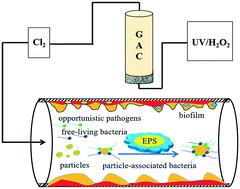当前位置:
X-MOL 学术
›
Environ. Sci.: Water Res. Technol.
›
论文详情
Our official English website, www.x-mol.net, welcomes your
feedback! (Note: you will need to create a separate account there.)
Effects of GAC and UV/H2O2-GAC filtration on the bacterial community and opportunistic pathogens in simulated drinking water systems
Environmental Science: Water Research & Technology ( IF 3.5 ) Pub Date : 2021-06-26 , DOI: 10.1039/d1ew00222h Lixin Huo 1 , Shehang Zhao 2 , Baoyou Shi 1, 3 , Shouyang He 4 , Haibo Wang 1, 3
Environmental Science: Water Research & Technology ( IF 3.5 ) Pub Date : 2021-06-26 , DOI: 10.1039/d1ew00222h Lixin Huo 1 , Shehang Zhao 2 , Baoyou Shi 1, 3 , Shouyang He 4 , Haibo Wang 1, 3
Affiliation

|
The effects of granular activated carbon (GAC) and UV/H2O2-GAC filtration on the bacterial community and opportunistic pathogens (OPs) in simulated drinking water systems were investigated in this study. The results indicated that GAC filtration and UV/H2O2-GAC filtration enhanced the dissolved organic carbon (DOC) and assimilable organic carbon (AOC) removal efficiency in the influents of drinking water distribution systems (DWDSs) by the removal of tryptophan-like proteins, fulvic acid-like, and humic acid-like compounds, compared with sand filtration (SF). The lower organic matter concentration reduced the diversity and richness of the bacterial community, inducing the production of lower extracellular polymeric substances (EPS) in these two DWDSs. EPSs with a lower content of proteins led to less bacterial attachment onto particles to form particle-associated bacteria, and adsorption onto the surface of pipes to form biofilms. This process induced a lower chlorine-resistance capability of the bacteria in water and biofilm in DWDSs. The relative abundance of Legionella at the genus level was 0.93%, 0.29%, and 0.13% in the biofilms of SF DWDSs, GAC DWDSs, and UV/H2O2-GAC DWDSs, respectively. Mycobacteria and Pseudomonas showed the same changes as Legionella. The quantitative polymerase chain reaction (qPCR) results also suggested that the number of Legionella pneumophila, Mycobacteria avium, and Pseudomonas aeruginosa were lower in the effluents and biofilms of GAC DWDSs and UV/H2O2-GAC DWDSs. Therefore, GAC filtration can be used to control OPs growth in DWDSs, and UV/H2O2 can improve the efficiency of GAC filtration, especially with the 48 h distribution in DWDSs.
中文翻译:

GAC 和 UV/H2O2-GAC 过滤对模拟饮用水系统中细菌群落和条件致病菌的影响
本研究调查了颗粒活性炭 (GAC) 和 UV/H 2 O 2 -GAC 过滤对模拟饮用水系统中细菌群落和条件致病菌 (OPs) 的影响。结果表明,GAC过滤和UV/H 2 O 2-GAC 过滤通过去除类色氨酸蛋白、类富里酸和类腐殖酸,提高了饮用水分配系统 (DWDS) 进水中溶解有机碳 (DOC) 和可同化有机碳 (AOC) 的去除效率与砂滤 (SF) 相比。较低的有机物浓度降低了细菌群落的多样性和丰富度,导致这两种 DWDS 产生较低的细胞外聚合物 (EPS)。蛋白质含量较低的 EPS 导致较少的细菌附着在颗粒上形成颗粒相关细菌,并吸附到管道表面形成生物膜。该过程导致 DWDS 中细菌在水中和生物膜中的耐氯能力较低。军团菌的相对丰度在SF DWDSs、GAC DWDSs和UV/H 2 O 2 -GAC DWDSs的生物膜中,属级水平分别为0.93%、0.29%和0.13% 。分枝杆菌和假单胞菌表现出与军团菌相同的变化。定量聚合酶链反应 (qPCR) 结果还表明,GAC DWDS 和 UV/H 2 O 2 -GAC DWDS的流出物和生物膜中嗜肺军团菌、鸟分枝杆菌和铜绿假单胞菌的数量较低。因此,GAC 过滤可用于控制 DWDS 中 OPs 的生长,以及 UV/H 2 O 2 可以提高 GAC 过滤的效率,尤其是 DWDS 中的 48 h 分布。
更新日期:2021-07-09
中文翻译:

GAC 和 UV/H2O2-GAC 过滤对模拟饮用水系统中细菌群落和条件致病菌的影响
本研究调查了颗粒活性炭 (GAC) 和 UV/H 2 O 2 -GAC 过滤对模拟饮用水系统中细菌群落和条件致病菌 (OPs) 的影响。结果表明,GAC过滤和UV/H 2 O 2-GAC 过滤通过去除类色氨酸蛋白、类富里酸和类腐殖酸,提高了饮用水分配系统 (DWDS) 进水中溶解有机碳 (DOC) 和可同化有机碳 (AOC) 的去除效率与砂滤 (SF) 相比。较低的有机物浓度降低了细菌群落的多样性和丰富度,导致这两种 DWDS 产生较低的细胞外聚合物 (EPS)。蛋白质含量较低的 EPS 导致较少的细菌附着在颗粒上形成颗粒相关细菌,并吸附到管道表面形成生物膜。该过程导致 DWDS 中细菌在水中和生物膜中的耐氯能力较低。军团菌的相对丰度在SF DWDSs、GAC DWDSs和UV/H 2 O 2 -GAC DWDSs的生物膜中,属级水平分别为0.93%、0.29%和0.13% 。分枝杆菌和假单胞菌表现出与军团菌相同的变化。定量聚合酶链反应 (qPCR) 结果还表明,GAC DWDS 和 UV/H 2 O 2 -GAC DWDS的流出物和生物膜中嗜肺军团菌、鸟分枝杆菌和铜绿假单胞菌的数量较低。因此,GAC 过滤可用于控制 DWDS 中 OPs 的生长,以及 UV/H 2 O 2 可以提高 GAC 过滤的效率,尤其是 DWDS 中的 48 h 分布。











































 京公网安备 11010802027423号
京公网安备 11010802027423号